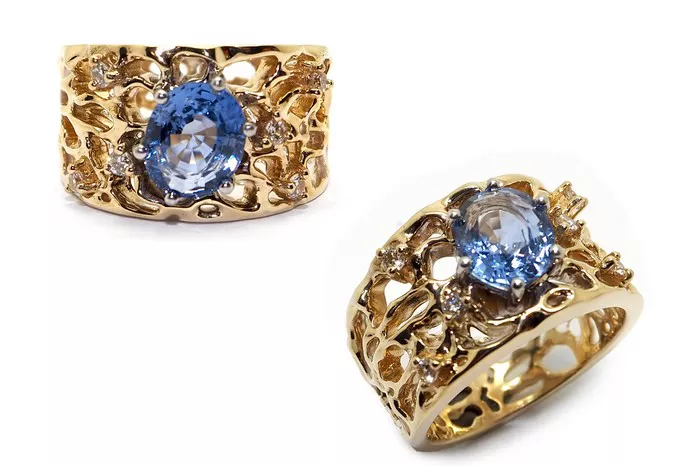Sapphires are a diverse group of gemstones known for their various colors, and milky yellow sapphires are an interesting subset. Understanding the cause of their color requires delving into the complex world of gemstone formation and the factors that influence their chemical and physical properties. Color in gemstones is not a random occurrence but is the result of specific elements, crystal lattice structures, and environmental conditions during formation.
Trace Elements and Color
Iron Content
One of the main factors contributing to the yellow color in sapphires, including milky yellow ones, is the presence of iron. Iron can exist in different oxidation states within the crystal lattice of the sapphire. In the case of yellow sapphires, iron is thought to substitute for other elements in the lattice. When iron is present in certain amounts and configurations, it can absorb specific wavelengths of light, resulting in the perception of a yellow color. The milky appearance may be related to the distribution of iron within the crystal. If the iron is not evenly distributed or if there are inclusions associated with the iron – containing regions, it can create a milky or hazy effect.
Other Trace Elements
Besides iron, other trace elements may also play a role. For example, titanium may be present in small amounts. Titanium can interact with iron and other elements in the sapphire lattice. It can potentially affect the color by modifying the energy levels of electrons within the crystal. The combination of different trace elements and their relative concentrations can fine – tune the color of the milky yellow sapphire. Chromium is another element that can be found in sapphires, although it is more commonly associated with red and pink sapphires. However, in some cases, small amounts of chromium may interact with iron and contribute to the overall color complex in a milky yellow sapphire.
Crystal Defects and Inclusions
Vacancies and Interstitial Atoms
Crystal defects such as vacancies (missing atoms in the lattice) and interstitial atoms (extra atoms in the lattice) can influence the color of milky yellow sapphires. These defects can create energy levels within the crystal that are different from the perfect lattice. When light interacts with these defective regions, it can be absorbed or scattered in different ways, leading to the milky appearance and the yellow color. Vacancies can act as centers for color – causing impurities to accumulate. For example, if iron atoms tend to accumulate around vacancies, it can enhance the yellow coloration.
Inclusions
Inclusions are foreign materials trapped within the sapphire during its formation. These can range from other minerals to gas bubbles. In milky yellow sapphires, inclusions can scatter light, which contributes to the milky or cloudy appearance. Some inclusions may also contain elements that can affect the color. For instance, if an inclusion contains a high concentration of iron – rich material, it can influence the overall yellow color of the sapphire. The type, size, and distribution of inclusions are important factors in determining the appearance and color of the milky yellow sapphire.
Geological Conditions during Formation
Temperature and Pressure
The temperature and pressure conditions during the formation of sapphires play a crucial role in determining their color. In the case of milky yellow sapphires, the specific temperature and pressure ranges can affect the incorporation of trace elements into the crystal lattice. Higher temperatures may favor the diffusion of iron and other elements into the lattice, while pressure can influence the crystal structure and the way these elements are arranged. If the temperature and pressure are not in the optimal range, it can lead to an imperfect lattice with a milky appearance and a yellow color.
Host Rock Composition
The composition of the host rock in which the sapphire forms can also impact the color. If the host rock contains a high concentration of iron – rich minerals, there is a greater likelihood of iron being incorporated into the growing sapphire crystal. The chemical exchange between the sapphire and the host rock during formation can be a source of the yellow color. Additionally, the presence of other elements in the host rock can influence the formation of inclusions and crystal defects, which in turn affect the color and appearance of the milky yellow sapphire.
Conclusion
In conclusion, the color of milky yellow sapphires is the result of a combination of factors. Trace elements such as iron, titanium, and potentially chromium play a significant role in creating the yellow color through their absorption of specific wavelengths of light. Crystal defects, including vacancies and interstitial atoms, and inclusions also contribute to both the milky appearance and the color. Geological conditions during formation, such as temperature, pressure, and host rock composition, further influence the incorporation of these elements and the development of the crystal structure. Understanding these factors is essential for gemologists, jewelers, and consumers alike to fully appreciate the beauty and value of milky yellow sapphires.
Related topic:
- Can I Wear Topaz Instead of Yellow Sapphire?
- The Benefits of Wearing Yellow Sapphire and Blue Sapphire Together
- Does Yellow Sapphire Suit All Gemini?


